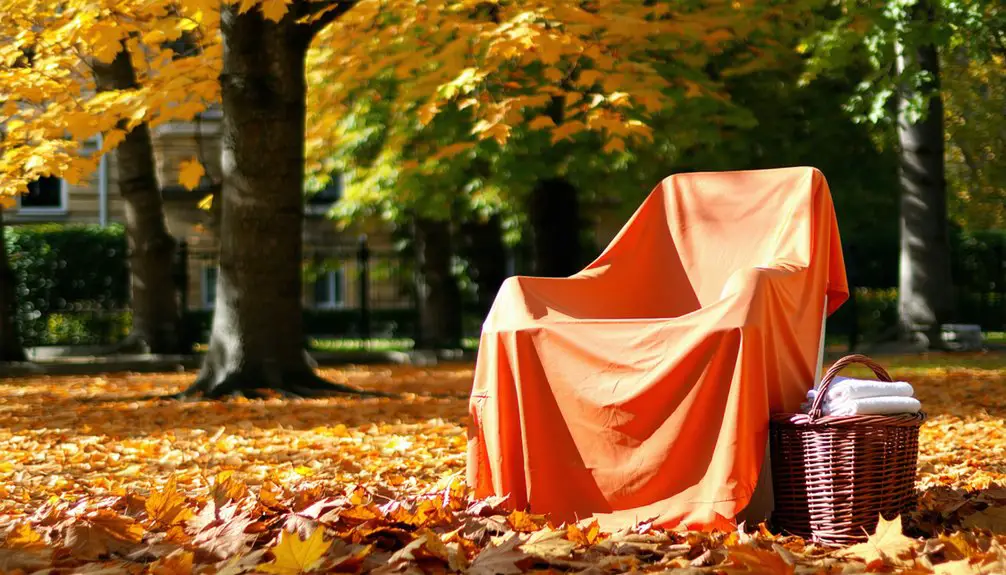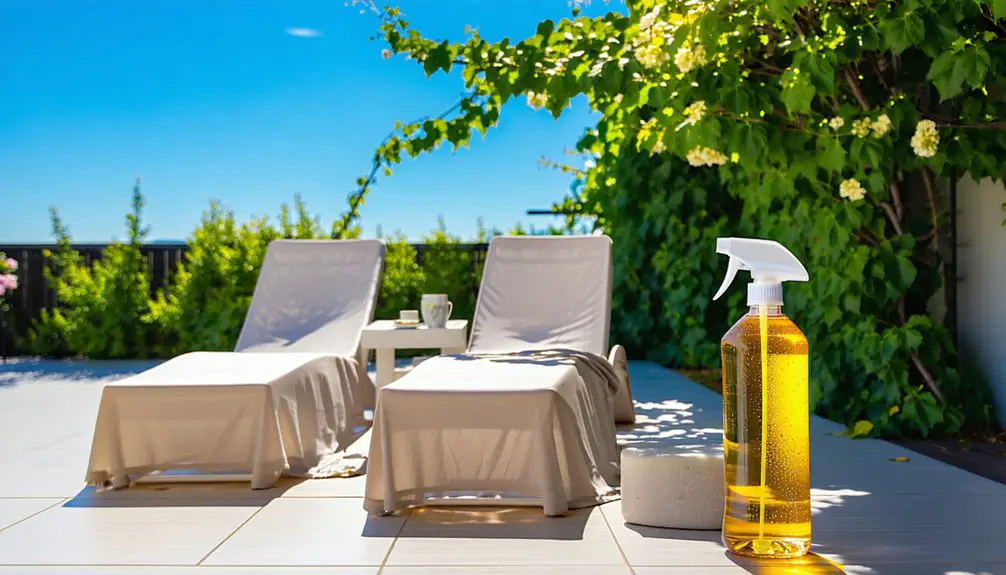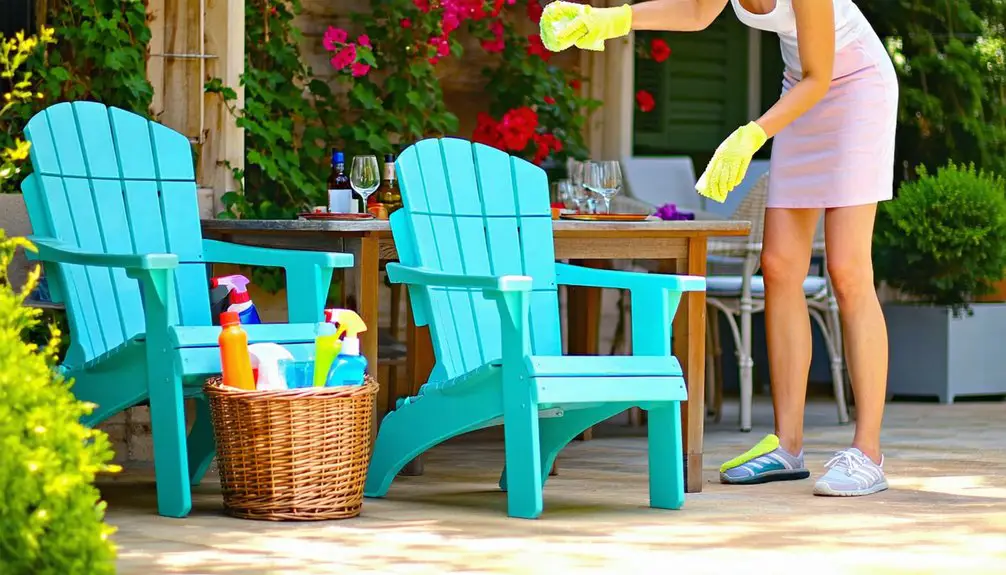For seasonal maintenance of your plastic furniture, start with regular cleaning to maintain its appearance. Use a dry vacuum or whisk broom to remove loose dirt, then scrub with a mix of mild dish soap and warm water. Rinse thoroughly and allow it to air dry. Before winter, inspect for damage and rinse with a hose. Cover furniture with breathable fabric to prevent moisture buildup. In spring, apply UV-resistant coatings and check for cracks or mold. By following these tips, you'll keep your furniture looking its best. Discover additional strategies to enhance your seasonal care.
Key Takeaways
- Regularly clean plastic furniture with a mild detergent and warm water to maintain appearance and remove dirt effectively.
- Inspect for winter damage like cracks or warps before covering furniture for fall.
- Use breathable fabric covers for outdoor storage to prevent moisture buildup and avoid mold growth.
- Elevate furniture on pallets during storage to prevent ground moisture damage and ensure proper ventilation.
- Apply UV-resistant coatings and arrange furniture in partial shade to protect against sun damage.
Cleaning and Maintenance Essentials
To keep your plastic furniture looking its best, regular cleaning is essential. Start by removing loose dirt and debris with a dry vacuum or a whisk broom.
Once the surface is clear, mix mild dish soap with warm water in a 5-gallon bucket. Grab a soft-bristle brush or a sponge and scrub the furniture gently. Rinse thoroughly with clean water to eliminate any soap residue, then let the furniture air-dry to prevent water spots.
When choosing cleaning solutions, avoid abrasive cleaners or harsh chemicals that could damage the plastic surface. Stick to pH-neutral cleaners, like a natural liquid dishwashing detergent mixed with warm water. For tougher stains, a mild detergent mixed with water works well. Use bleach sparingly and only if necessary; if you do, mix one part bleach to two parts water. Regularly check for buildup from poor weather conditions to ensure your cleaning is effective.
Protect your furniture from the elements by avoiding prolonged exposure to direct sunlight, which can cause fading and brittleness. Also, consider applying UV protectors to prevent damage from sunlight.
During extreme weather, consider storing your furniture in a shed or garage. Using patio furniture covers can also help shield against rain, wind, and sun, ensuring your furniture remains in great condition.
Spring Preparation Steps
After giving your plastic furniture a thorough cleaning and ensuring it's well-protected from the elements, it's time to prepare for spring.
Start by inspecting your furniture for any winter damage. Look for cracks, warps, or breaks caused by snow and ice. Don't forget to check the hardware; ensure bolts and screws aren't loose or corroded. Keep an eye out for mold or mildew as well.
Next, rinse your furniture down with a hose to remove dirt and debris. Use a mild detergent mixed with lukewarm water for a deeper clean. For tough grime or stains, try a solution like Dawn Powerwash or a vinegar-water mix. Rinse thoroughly and let it air-dry or wipe it down to prevent water spots. Remember that composite furniture is designed to resist cracking and rotting, making it a durable choice for outdoor use.
If your furniture has fabric cushions, wash them using a mild laundry detergent and let them dry completely before placing them back.
Consider applying a waterproof protectant spray for extra defense against the elements.
Lastly, tidy up your outdoor space by cleaning surfaces, organizing furniture for airflow, and ensuring everything is debris-free, so you're ready to enjoy the season!
Fall Care and Covering

As fall approaches, it's essential to clean your plastic furniture thoroughly before covering it for the season. Start by removing dirt and grime with a hose and a gentle cleaning solution to ensure it stays in good condition. Proper maintenance not only keeps your furniture looking great but also extends its lifespan. Once cleaned and dried, use proper storage techniques to protect your furniture from the harsh winter elements.
Clean Before Covering
Cleaning your plastic furniture before covering it for the fall is essential for maintaining its longevity and appearance. Start with a thorough cleaning to remove dirt, leaves, and debris. Use a soft bristle brush and a mild detergent mixed with lukewarm water.
For stubborn stains, mix warm water, mild dish soap, and one cup of bleach. Don't forget to vacuum the furniture with a brush attachment to clear loose dirt.
Once you've cleaned, allow your furniture to air-dry completely to prevent water spots—just avoid direct sunlight during this process. If your furniture has removable cushions or fabric covers, wash those separately.
Make sure every part is dry before covering to keep moisture at bay. Additionally, consider using breathable fabric covers to prevent moisture buildup, which can lead to mold growth.
While cleaning, inspect hardware like bolts and screws for looseness or corrosion. Tighten or replace any loose parts and check for signs of wear.
Lastly, choose breathable fabric covers instead of plastic ones to avoid trapping moisture. Secure these covers with ropes or bungee cords, ensuring they fit snugly to keep water out.
Regular maintenance now will save you headaches later!
Proper Storage Techniques
When it comes to proper storage techniques for your plastic furniture during the fall, choosing the right materials and methods is crucial.
Start by using breathable fabric dust covers to prevent moisture buildup. Avoid plastic wrap since it traps moisture and can lead to mold and mildew. Look for outdoor tarps or furniture covers that allow ventilation, and make sure to secure them with ropes or bungee cords to withstand wind. Additionally, remember to elevate furniture on pallets to prevent moisture from the ground from causing damage.
Good ventilation is key, so ensure that air can circulate around the furniture. Lay down pallets or breathable sheets to prevent moisture from seeping in from the ground. Regularly check your covers for any weather damage, and always cover all parts of the furniture, including removable components.
If possible, place your furniture in a sheltered area to reduce exposure to harsh weather. For additional protection, consider applying a waterproof protectant spray and storing cushions indoors.
Disassembling furniture can also help save space and protect vulnerable parts. Don't forget to inspect everything periodically to catch any signs of damage early.
Following these tips will keep your plastic furniture in great shape throughout the fall and winter months.
Proper Storage Techniques
When it comes to storing your plastic furniture, choosing the right location is key.
Make sure you find a dry, cool space with good ventilation to keep moisture and pests at bay.
Protect your furniture with breathable covers to shield it from the elements and ensure it stays in top shape until you need it again.
Ideal Storage Locations
Finding the right storage location for your plastic furniture is crucial to maintaining its longevity and appearance. Proper storage can help prevent damage from harsh weather and prolong the life of your pieces. Here are four ideal storage locations to consider:
1. Garage or Basement
This option protects your furniture from ice, snow, and extreme cold, helping to prevent cracking.
It also keeps your furniture dry and out of direct sunlight, which can cause fading.
2. Detached Garage or Shed
If indoor storage isn't available, use a detached garage or shed.
Make sure to clean and dry your furniture thoroughly before storing, and consider stacking or nesting pieces to save space.
3. Storage Units
If your garage or basement isn't an option, a storage unit can provide a secure and dry environment.
Look for units with climate control to protect against extreme weather conditions.
4. Outdoor Storage with Covers****
If you must store outdoors, use sturdy, breathable covers.
Always clean and dry your furniture beforehand, and ensure the covers fit snugly to prevent moisture buildup.
Ventilation and Protection
Storing your plastic furniture properly goes beyond just finding the right location; it also involves ensuring adequate ventilation and protection during storage.
Use breathable covers to allow air circulation, preventing moisture buildup. Avoid plastic shrink wrap, as it can trap humidity and lead to condensation. Before covering your furniture, make sure it's completely dry to ward off mold and mildew.
Invest in high-quality, waterproof, and UV-resistant covers to shield your furniture from the elements. Choose breathable materials like cotton that allow air to flow, ensuring they aren't too tight.
Elevate your furniture off the ground using wooden pallets or concrete blocks to improve air circulation and minimize moisture absorption.
Regularly check on your stored furniture every 2-3 months for any signs of moisture, mold, or pests. Open the storage area occasionally to refresh the air and reduce the risk of moisture buildup.
Sun Protection Strategies

Protecting your plastic furniture from the sun's harsh rays is essential for maintaining its appearance and longevity. Here are some effective sun protection strategies you can easily implement:
1. Use UV-Resistant Coatings**: Apply UV-resistant paints like Krylon or Rust-oleum** to shield your furniture.
Regularly reapply these coatings to keep protection strong.
2. Strategic Placement: Arrange your furniture in areas that receive partial shade or utilize natural shade from trees or buildings.
Avoid spots with direct sunlight throughout the day.
3. Install Retractable Awnings**: Consider adding retractable awnings made from marine-grade acrylic fabric**.
This allows you to block out sunlight when needed while enjoying the sun when desired.
4. Store During Off-Season: When not in use, store your plastic furniture in a dark, dry place.
Use breathable covers to prevent mold growth and apply waterproof sprays for added protection during storage.
Regular Inspection Practices
Regular inspections are crucial for keeping your plastic furniture in top shape throughout the seasons. By regularly checking for damage and performing maintenance, you can prevent minor issues from becoming major problems. Start by inspecting for cracks or damage, especially after winter. Look for signs of mold or mildew if the furniture was covered, and check for fading due to sun exposure. Ensure the structural integrity of the furniture; a wobbly chair can lead to accidents.
Here's a quick checklist to guide your inspections:
| Inspection Focus | Action Required |
|---|---|
| Damage | Look for cracks and structural issues. |
| Mold/Mildew | Check for growth, especially under covers. |
| Cleaning | Remove dust and clean with appropriate solutions. |
| Color Discoloration | Examine for fading and treat as needed. |
| Stability | Ensure all pieces are firm and secure. |
Taking these steps will help extend the life of your plastic furniture. Address any issues you find promptly to keep everything looking great and functioning well. Regular care ensures your outdoor space stays inviting and enjoyable all year round.
Frequently Asked Questions
Can I Use Bleach to Clean Plastic Furniture?
You can use bleach to clean plastic furniture, but be cautious. It effectively removes stains, yet it can weaken the plastic and cause discoloration. Opt for mild soaps or vinegar for safer, regular cleaning instead.
How Often Should I Clean My Plastic Furniture?
You should clean your plastic furniture every two weeks or at least once a month, depending on usage and environmental conditions. Wipe it down immediately if you see dirt or stains for better maintenance.
What Types of Plastic Are Most Durable for Outdoor Use?
When choosing durable plastics for outdoor use, consider HDPE for strength and corrosion resistance, polycarbonate for impact resistance, and polypropylene for weather resilience. These materials ensure your outdoor furniture lasts through various conditions.
Is It Safe to Use a Pressure Washer on Plastic Furniture?
It's not safe to use a pressure washer on plastic furniture. The high pressure can damage the surface, strip paint, and cause scratches. Stick to mild detergents and soft cloths for effective cleaning instead.
How Can I Remove Tough Stains From Plastic Furniture?
To remove tough stains from plastic furniture, mix vinegar with water, apply it, scrub gently, and rinse. Alternatively, use baking soda paste or oxygen bleach for deeper cleaning, ensuring you rinse thoroughly afterward.

